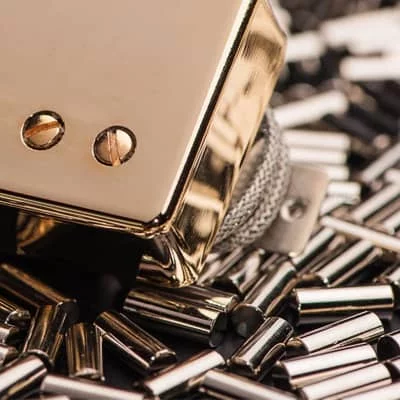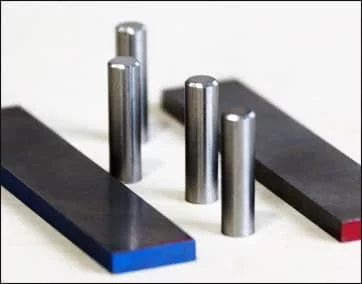
KNOW the Different Types and Characteristics of Guitar Pickups Magnets: Alnico Magnet vs. Ceramic Magnet. Become an expert in one of the most decisive components of the electric guitar.
Why Know the Types of Guitar Pickup Magnets?
A large number of factors can influence the final sound of an electric guitar. So it is vital to know its different components, so as not to fail in a possible improvement such as a change of pickups.
One of these factors that can sometimes be overlooked is the type of magnet that our pickups mount, regardless of the copper wire winding. The other factor that makes up an electromagnetic pickup.
Focusing many times, simply on the type of pickup that we want to acquire. Such as humbuckers or simple pickups, and in their output power.
But knowing the characteristics and qualities of the different magnets in electric guitar pickups will guide us effectively in the search for the sound that interests us the most.
It is always highly advisable to be well informed about the characteristics of the set of pickups that our guitar integrates, in order to act accordingly when choosing the replacement set.
For example, if our guitar has ceramic magnets, and we want to change the pickups to obtain a softer string attack than the characteristic and powerful attack of this type of magnet, it won’t do any good to change them for pickups of similar qualities, although the new pickup is of higher quality. Since the explosive attack will continue to appear anyway.
It would be more advisable to opt for alnico magnet pickups, to soften the violence in which the note appears when attacking the string.
This does not mean that some magnets are better than others. Since precisely if we want to improve our string attack, we would possibly have to follow the previous example, but in reverse.

MAGNETS ALNICO for Guitar Pickups
We will begin by analyzing the qualities of alnico magnets and their different variations, this magnet being formed mainly by an alloy of aluminum, nickel and cobalt. Hence the name alnico magnets.
This type of magnet has different variations in its composition and manufacturing materials. But the most important thing is to know their different numbers:
Alnico II
One of the best known and most popular electric guitar magnets. It offers a smooth traditional-style sound, without too much emphasis on either bass or treble. Giving the sensation of offering a compressed sound. A very suitable magnet for clean sounds, since it offers a transparent tone, at the same time that it avoids shrillness.
For example, Mark Knopfler uses a Seymour Duncan APS-1 Alnico II Pro on his red Schecter to get a very balanced classic Stratocaster tone.
But this type of magnet also performs very well on moderately distorted sounds, and on double-coil pickups. Very appropriate for blues and rock style guitar solos.
For example the guitarist Slash is another fan of the Alnico II. Mounting his custom models developed by Seymour Duncan the Alnico II as a characteristic quality. We can find alnico II in traditional humbucker pickups like the charismatic Gibson ’57 Classic.
In short, the alnico II offers a sweet sound, although as I have commented, other factors such as the copper wire winding of our pickups may influence it. Not to mention other factors that can be decisive for our sound, such as the type of guitar and amplifier.
Alnico III
If the alnico II magnet is considered classic or traditional, the Alnico III would be even more so. The magnet used in the first Telecaster models of the 50s developed by Fender.
The Alnico III has less magnetism than the Alnico II, but with a more open sound and a more accentuated brightness. Finding this type of magnet in current recreations of Fender pickups for Telecaster, such as the ’51 Nocaster model and or the Original Vintage.
Alnico IV
This magnet would be the previous example, but in a humbucker pickup version. The Alnico IV was the traditional magnet used to develop the first models of double-coil pickups created by Seth Lover for the Gibson brand, known as the PAF humbucker.
The Alnico IV Offering a classic-style smooth output, and a crisp bright tone. This magnet is used in pickup models as charismatic as the Seymour Duncan Saturday Night Special.
Alnico V
Possibly the most popular magnet for electric guitar pickups today, with permission from Alnico II. The Alnico V is a more aggressive magnet within this type of alloy, but at the same time very versatile. Since depending on the type and winding of the pickup in question, we can obtain low, medium, and high output pickups.
The alnico V has strong bass, while maintaining penetrating treble that will make us have a greater presence when we play with other instruments such as bass and drums.
Alnico VIII
It is used in some pickup models such as the Seymour Duncan SH-15 Alternative 8. A high output pickup in the style of a ceramic magnet pickup, but with the warm touch of alnico magnets. But there would be few models that can be found with this type of magnet.
The Alnico VIII would be a higher power version of the Alnico V, more aggressive and even brighter. In short, the essence of what is known as modern sound.
MAGNETS CERAMIC for Guitar Pickups
Ceramic Magnets are the kings of the aforementioned modern sound, and of high gain pickups. However, it is also possible to find pickups with vintage-style ceramic magnets. Although honestly it would not be the most appropriate type of magnet for a traditional instrument.
Ferrite magnets offer powerful treble, and clipped bass. For this reason, they are inappropriate pickups for clean sounds. Deploying its full potential in distorted sounds, by maintaining optimal presence and definition, preventing highly distorted sounds from appearing excessively cloudy.
The distortion name even appears in mythical models of this type of pickup such as the DiMarzio Super Distortion, or the Seymour Duncan SH-6 Duncan Distortion.
Although these would be the standard qualities of the different magnets in electric guitar pickups, there is no mathematical rule. Since as has been commented, there are other factors such as the size of the magnet, the thickness of the copper wire, the number of turns of which the coil is made up, and the resistance of the coil to electric current.
